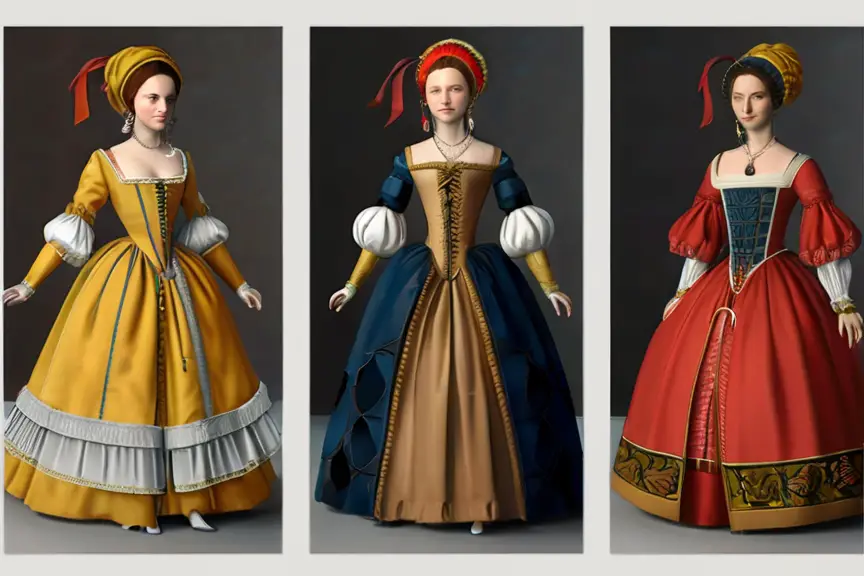
The Renaissance period, spanning from the 14th to the 17th century, was a time of great artistic, cultural, and fashionable innovation.
In this blog post, we’ll explore the key features of Renaissance fashion and the evolution of style during the Early, High, and Late Renaissance periods.
Key Features of Renaissance Fashion
Key Features of Renaissance Fashion:
- Opulent materials: Luxurious fabrics like silk, velvet, and brocade were popular, showcasing wealth and prosperity.
- Puffed sleeves and drama: Puffed sleeves were a defining feature of Renaissance women’s gowns, adding a sense of drama and sophistication.
- Cinched waists and the hourglass silhouette: The hourglass figure was a Renaissance fashion ideal, achieved through the use of corsets and cinched waists.
- Artistry in embroidery: Intricate embroidery designs and embellishments were common in Renaissance fashion, elevating the aesthetic value of clothing.
- Voluminous skirts and regal splendor: Italian gowns featured voluminous skirts that added a sense of regal splendor and emphasized the wearer’s status.
- The renaissance hat: Hats played a significant role in Renaissance fashion, ranging from berets to extravagant feathered creations.
The Early Renaissance (14th-1450s)

During the Early Renaissance, which spanned from the 14th century to the 1450s, fashion underwent notable changes in both men’s and women’s attire.
Let’s delve into the distinct elements that defined the clothing of this era.
- Read also: Renaissance Art Vs. Medieval Art
- Read also: Exploring Famous Renaissance Architecture
Men’s fashion
Houppelandes
Men’s fashion during this period featured the houppelande, a long gown characterized by its flowing silhouette and dagged sleeves.
These sleeves were cut into decorative points, adding a touch of elegance to the garment.
Doublets and hose
Alongside houppelandes, men also embraced the introduction of doublets and hose.
Doublets were short, close-fitting jackets worn over shirts, providing a more structured look to the upper body.
Hose, fitted tights worn on the legs, complemented the ensemble, contributing to a streamlined appearance.
Hats
The headwear of choice for men included chaperons, which were essentially hoods worn with a cape that draped over the shoulders, providing both warmth and style.
Additionally, berets emerged as a popular alternative, offering a simpler yet fashionable option for head covering.
Women’s fashion
Long gowns
Women’s fashion during the Early Renaissance favored long gowns with fitted bodices and flowing skirts.
These gowns accentuated the female form while allowing for ease of movement, reflecting the ideal of graceful femininity.
High waistline
A notable feature of women’s attire during this period was the emphasis on a high waistline.
This design choice created an elongated silhouette and drew attention to the upper body, enhancing the overall elegance of the ensemble.
Hennins
In the early 15th century, hennins gained popularity as distinctive headdresses worn by women.
These tall, pointed hats, often adorned with veils or decorative embellishments, added height to the wearer’s silhouette and became synonymous with the fashion of the era.

The High Renaissance (1450-1500s)
During the High Renaissance, spanning from the 1450s to the 1500s, significant shifts in fashion occurred, reflecting the evolving tastes and cultural influences of the time.
Let’s explore the distinct characteristics of men’s and women’s attire during this period in greater detail.
Men’s fashion
Shorter and tighter doublets
One notable change in men’s fashion was the evolution of doublets.
Doublets became shorter and tighter, emphasizing the natural contours of the body.
Puffed sleeves, often slashed for decorative effect, added a touch of sophistication to these garments, showcasing intricate tailoring and craftsmanship.
Breeches
Below the knee, breeches replaced hose as the preferred lower-body garment for men.
Breeches provided a more structured and tailored look, contributing to the overall refinement of men’s attire during the High Renaissance.
Emphasis on broad shoulders and narrower waist
The silhouette of men’s fashion during this period emphasized broad shoulders and a narrower waist, creating a visually striking and balanced profile.
This aesthetic ideal was achieved through careful tailoring and the use of fabrics that provided structure and support.
Hats
Flat caps and berets emerged as popular choices for men’s headwear during the High Renaissance.
These hats offered a more understated yet stylish alternative to the elaborate headwear of previous eras, complementing the refined simplicity of men’s attire.
Women’s Fashion
Lower waistline and wider skirts
Women’s fashion during the High Renaissance saw a shift towards dresses with a lower waistline, emphasizing the natural waist.
The skirts became wider and more flowing, allowing for greater freedom of movement and exuding an air of elegance and grace.
Introduction of the kirtle
A significant innovation in women’s fashion was the introduction of the kirtle, a fitted underdress worn beneath outer garments.
The kirtle provided structure and support to the overall silhouette, enhancing the fit and drape of the outer gown.
Less dramatic headwear
Unlike the towering headdresses of the previous era, headwear for women during the High Renaissance became less dramatic.
Veils and jeweled nets emerged as popular choices, adding a touch of refinement and sophistication to women’s ensembles without overshadowing the overall look.

The Late Renaissance (1500s-1600s)
As the Renaissance progressed into the late 1500s and 1600s, fashion underwent further evolution, marked by distinct changes in both men’s and women’s attire.
Let’s delve deeper into the unique characteristics of fashion during this period.
Men’s fashion
Shorter and more padded doublets
Doublets continued to evolve, becoming even shorter and more padded during the late Renaissance.
This emphasis on padding created a pronounced silhouette, while exaggerated codpieces, triangular flaps worn over the groin area, became a prominent feature of men’s attire, symbolizing masculinity and virility.
Looser and puffed breeches
In contrast to the fitted breeches of earlier periods, late Renaissance fashion saw the emergence of looser and more voluminous breeches.
These puffed garments added a sense of extravagance and opulence to men’s ensembles, reflecting the luxury and excess often associated with the era.
Elaborate collars with lace ruffs
Collars grew increasingly elaborate during the late Renaissance, adorned with intricate lace ruffs that framed the face and neckline.
These ornate collars served as a symbol of status and refinement, adding a touch of sophistication to men’s attire and highlighting the importance of intricate craftsmanship in fashion.
Hats
Wide-brimmed hats and feathered caps became popular choices for men’s headwear during the late Renaissance.
These accessories added flair and drama to ensembles, complementing the extravagant nature of men’s fashion during this period.
Women’s Fashion
Emphasis on elongated torso
Women’s dresses during the late Renaissance emphasized an elongated torso, achieved through the use of pointed bodices and wide, flattened skirts.
These silhouettes accentuated the natural curves of the body while creating a sense of elegance and grace.
Farthingales
To achieve the desired wide skirt silhouette, farthingales, hoop structures worn beneath the skirt, became essential elements of women’s fashion.
These structures provided support and shape to the skirt, enhancing its volume and creating a striking visual impact.
Elaborate sleeves and necklines
Late Renaissance women’s fashion featured elaborate sleeves and necklines adorned with lace ruffs, mirroring the ornate collars seen in men’s attire.
These intricate details added a sense of luxury and refinement to women’s dresses, elevating them to objects of beauty and admiration.

- Read also: Renaissance Invention Timeline
- Read also: Top 7 Great Renaissance Artists
Conclusion
Renaissance fashion was a testament to the artistic and cultural achievements of the period.
From the flowing gowns of the Early Renaissance to the elaborate designs of the Late Renaissance, fashion played a significant role in expressing the wealth, status, and tastes of the time.
FAQs
Expensive materials like silk, velvet, and brocade were commonly used in Renaissance fashion, along with intricate embroidery, beading, and lace.
Renaissance fashion was characterized by more elaborate, ornate designs and an emphasis on luxury and comfort, while medieval fashion was simpler and more practical.
Fashion played a significant role in expressing wealth, status, and tastes in Renaissance society, as well as reflecting the artistic and cultural achievements of the period.
Renaissance fashion has had a lasting impact on modern fashion, with elements like puffed sleeves, lace ruffs, and high-waisted skirts still popular today.
Renaissance fashion was generally more elaborate for women, with a focus on flowing skirts, fitted bodices, and elaborate headwear, while men’s fashion was characterized by shorter, tighter doublets and breeches, and simpler hats.


